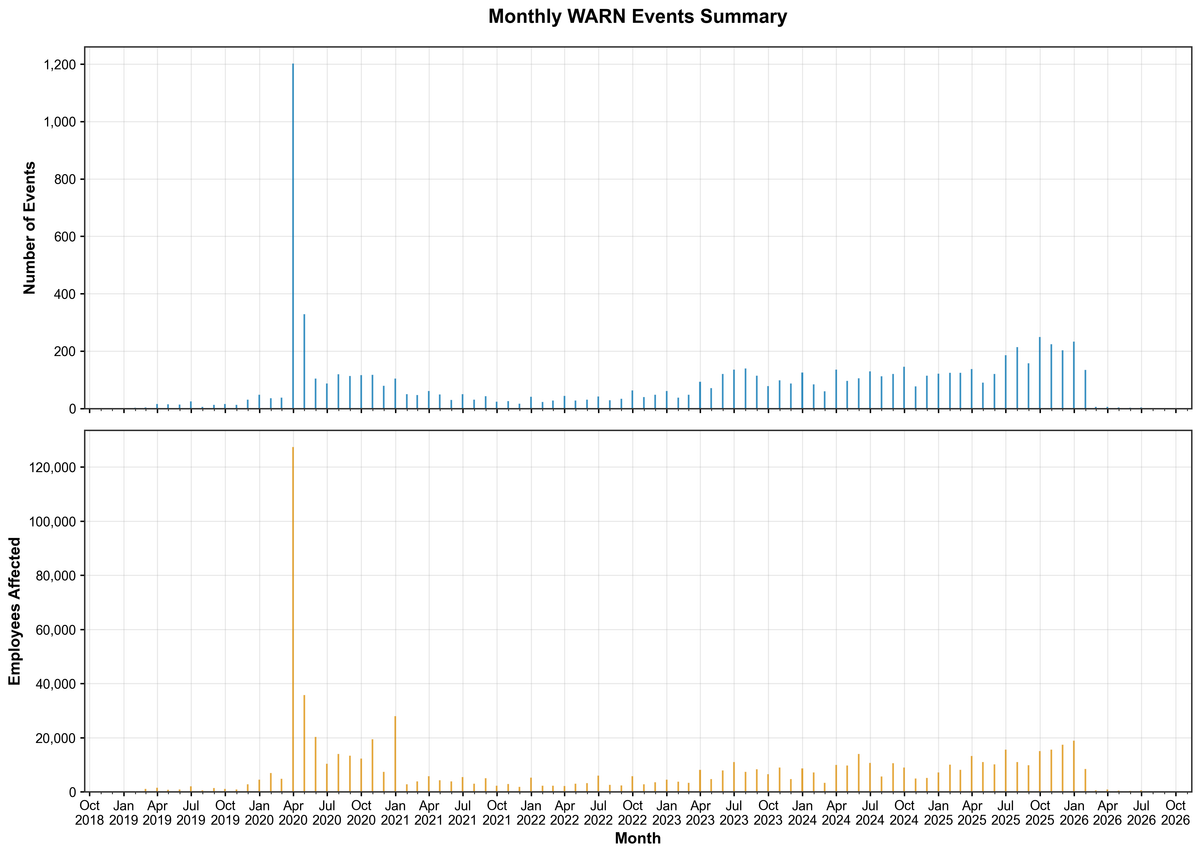Deep dive into 657,463 affected workers and what it means for investors
2025 Layoff Surge: What WARN Data Reveals About the Labor Market
The quiet drumbeat of WARN notices—those mandatory alerts companies file before mass layoffs—turned into a crescendo in late 2025. Across America, 657,463 workers have been caught in the wave since January 2022, with 2025 alone accounting for 143,050 affected employees. That's a 66% jump from 2024's 86,169, and the acceleration is unmistakable in the second half of the year.
For investors, this isn't just about unemployment numbers—it's a window into corporate cost-cutting, sector stress, and regional economic health. Let's dive into what the data reveals.
The Acceleration: 2025's Sharp Turn

While 2024 hummed along at roughly 7,181 affected workers per month, 2025 shifted into overdrive with an average of 11,921 monthly. The real story emerges in the back half: June kicked off with 14,315 affected, building to a year-end crescendo of 18,722 in December. This pattern screams corporate budget resets and Q4 restructuring initiatives.
The median event size tells an interesting story: 37 workers versus an average of 74.9. Translation? Most layoffs are small and localized, but a handful of massive events—like the puzzling 16,132-worker "Tend Exchange" closure in California—skew the numbers dramatically.
Where the Pain Concentrates: California, Texas, and the Rust Belt
California dominates by sheer volume—4,529 events affecting 279,527 workers (42.5% of the national total). But don't confuse quantity with severity. California's average event size of 61.7 workers is actually below the national average, pointing to comprehensive WARN reporting and a diverse economy generating many smaller dislocations.
Interactive visualization: Explore layoff patterns across all 50 states with filtering by time period.
Texas and New York tell a different story with average event sizes of 103.7 and 113.5 respectively. These are corporate restructuring territories—think Tesla's Austin campus shedding 2,688 workers, Walmart's DFW consolidations, or New York's media sector upheavals at Paramount (819) and Spotify (755). When these states report WARN notices, they tend to be substantial.
The Upper Midwest—Iowa, Minnesota, Wisconsin—showcases manufacturing and food processing vulnerability. Minnesota's exceptionally low 21.8 average suggests many small-scale closures, while Iowa's Perry plant shutdown (1,276 workers) exemplifies the single-employer town catastrophe.
Sector Stress Test: Tech, Retail, and Industrial
Technology & Telecom: The Efficiency Drive
Tesla leads with 4,140 total (2,688 in Austin, 1,452 in Fremont), while semiconductor heavyweights Broadcom (1,267) and Qualcomm (1,064) signal hardware sector pressure. U.S. Cellular's massive 4,100-worker multi-state action suggests consolidation in regional telecom. For investors: watch for continued "efficiency" narratives in earnings calls—this trend isn't over.
Retail: The Footprint Rationalization
Walmart's 2,313 combined Texas cuts (Dallas and Fort Worth) and legacy retailer collapses (Bed Bath & Beyond: 1,000) underscore ongoing brick-and-mortar consolidation. Omnichannel winners are still pruning physical presence; pure-play traditional retailers are in survival mode.
Industrial & Energy: Project Cycles Bite
Zachry Industrial's 4,072-worker Sabine Pass LNG wind-down is classic project-phase economics. These aren't permanent jobs disappearing—they're construction crews cycling off completed megaprojects. But for Gulf Coast communities and staffing firms, the impact is real and immediate.
Food Processing: Margin Pressure & Consolidation
Smithfield Distribution's 1,755-worker California closure, FirstFruits' 1,200 in Washington, and multiple ice cream plant shutdowns (Dreyer's Grand Ice Cream: 1,015) point to squeezed margins and capacity rationalization. Ag-dependent regions should brace for continued volatility.
Temporal Patterns and Trends

The late-2025 surge shows clear Q4 acceleration. Closures account for 26% of all events (2,660 total)—these aren't temporary headcount trims but permanent capacity exits, indicating fundamental restructuring across sectors.
What This Means for Your Portfolio
1. Corporate Margin Expansion Play
These restructurings aren't spontaneous—they're deliberate margin expansion initiatives. Companies taking near-term charges to reduce ongoing opex often see multiple expansion 12-18 months out. Look for firms with substantial Q4 2025 restructuring announcements for potential 2026 margin improvement stories.
2. Regional Economic Divergence
The concentration in California, Texas, and Florida—with very different event characteristics—suggests regional real estate, consumer spending, and municipal bond performance will increasingly diverge. California's many small events might be absorbed more easily than Texas's mega-facility closures.
3. Staffing & Workforce Solutions Opportunity
With 143,050 workers displaced in 2025 alone, demand for workforce transition services, training providers, and contingent staffing should remain elevated. Companies positioned in rapid-response workforce solutions may see sustained tailwinds.
4. Consumer Discretionary Headwinds
The Q4 2025 surge suggests consumer spending in affected regions may face pressure in H1 2026. Retailers, restaurants, and auto dealers in high-layoff metros should be monitored for same-store sales weakness.
Important Data Caveats
Before making portfolio decisions:
- 2026 data beyond January appears incomplete due to reporting lags
- 27% of events are classified as "unknown" type, limiting precise sectoral analysis
- Some large events (like the 16,132 Tend Exchange closure) may represent data artifacts or platform-wide batch updates rather than traditional layoffs
- Multi-state corporate actions sometimes generate duplicate entries across state systems
The Bottom Line
The late-2025 WARN surge isn't a sudden crisis—it's a coordinated efficiency drive across sectors adjusting to post-pandemic demand normalization, persistent inflation pressure, and higher-for-longer interest rates. Tech and media companies are harvesting earlier hiring excesses. Retailers continue brick-and-mortar rationalization. Industrial and energy firms cycle through project completions.
For investors, this creates a nuanced picture: near-term consumer spending headwinds in affected metros, but potential margin expansion upside for companies executing well-planned restructurings. Watch initial jobless claims in California, Texas, and the Upper Midwest—and keep an eye on which sectors issue guidance assuming lower headcount-driven opex.
The WARN data doesn't predict the market's next move—but it does illuminate which companies and regions are actively reshaping their cost structures. In 2026, that reshaping will flow through to earnings, spending patterns, and investment returns.
---
Data Source: State WARN notice databases aggregated January 2022 - January 2026. Analysis covers 10,299 events affecting 657,463 workers across all 50 states.